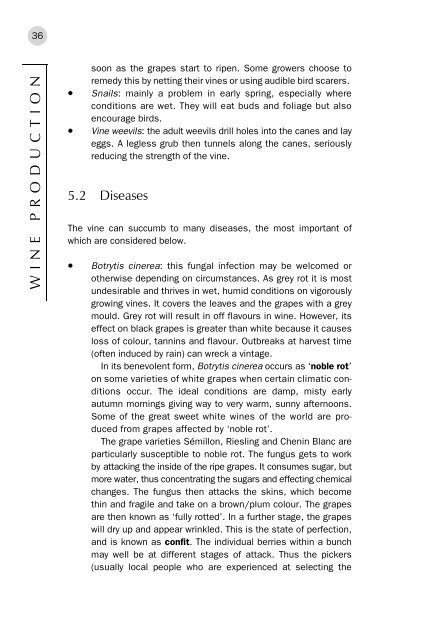Wine Production : Vine to Bottle - Vinum Vine
Wine Production : Vine to Bottle - Vinum Vine
Wine Production : Vine to Bottle - Vinum Vine
Create successful ePaper yourself
Turn your PDF publications into a flip-book with our unique Google optimized e-Paper software.
36<br />
WINE PRODUCTION<br />
soon as the grapes start <strong>to</strong> ripen. Some growers choose <strong>to</strong><br />
remedy this by netting their vines or using audible bird scarers.<br />
• Snails: mainly a problem in early spring, especially where<br />
conditions are wet. They will eat buds and foliage but also<br />
encourage birds.<br />
• <strong>Vine</strong> weevils: the adult weevils drill holes in<strong>to</strong> the canes and lay<br />
eggs. A legless grub then tunnels along the canes, seriously<br />
reducing the strength of the vine.<br />
5.2 Diseases<br />
The vine can succumb <strong>to</strong> many diseases, the most important of<br />
which are considered below.<br />
• Botrytis cinerea: this fungal infection may be welcomed or<br />
otherwise depending on circumstances. As grey rot it is most<br />
undesirable and thrives in wet, humid conditions on vigorously<br />
growing vines. It covers the leaves and the grapes with a grey<br />
mould. Grey rot will result in off flavours in wine. However, its<br />
effect on black grapes is greater than white because it causes<br />
loss of colour, tannins and flavour. Outbreaks at harvest time<br />
(often induced by rain) can wreck a vintage.<br />
In its benevolent form, Botrytis cinerea occurs as ‘noble rot’<br />
on some varieties of white grapes when certain climatic conditions<br />
occur. The ideal conditions are damp, misty early<br />
autumn mornings giving way <strong>to</strong> very warm, sunny afternoons.<br />
Some of the great sweet white wines of the world are produced<br />
from grapes affected by ‘noble rot’.<br />
The grape varieties Sémillon, Riesling and Chenin Blanc are<br />
particularly susceptible <strong>to</strong> noble rot. The fungus gets <strong>to</strong> work<br />
by attacking the inside of the ripe grapes. It consumes sugar, but<br />
more water, thus concentrating the sugars and effecting chemical<br />
changes. The fungus then attacks the skins, which become<br />
thin and fragile and take on a brown/plum colour. The grapes<br />
are then known as ‘fully rotted’. In a further stage, the grapes<br />
will dry up and appear wrinkled. This is the state of perfection,<br />
and is known as confit. The individual berries within a bunch<br />
may well be at different stages of attack. Thus the pickers<br />
(usually local people who are experienced at selecting the
















